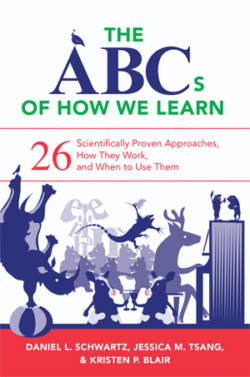Excerpted from "The ABCs of How We Learn: 26 Scientifically Proven Approaches, How They Work, and When to Use Them," (c) 2016 by Daniel L. Schwartz, Jessica M. Tsang and Kristen P. Blair. Used with the permission of the publisher, W. W. Norton & Co. The following is from the chapter "L is for Listening and Sharing."
Learning more together than alone
With listening and sharing learners try to construct joint understandings. Listening and sharing are the cornerstones of collaborative learning. We can learn more working together than working alone.
A little history lesson: The study of cooperation arose after World War II as part of a research program on conflict resolution (Deutsch, 1977). Negotiation depends on cooperation, and negotiation is a preferable resolution to conflict than war. From this starting point, one reason to use cooperative learning is to help students develop better skills at cooperating (e.g., Johnson & Johnson, 1987). Subsequent research discovered a second reason to use cooperative learning: when students collaborate on class assignments, they learn the material better (we provide examples below). Ideally, small group work can yield both better abilities to cooperate and better learning of the content.
Simply putting students into small groups, however, does not guarantee desirable outcomes. Success depends on listening and sharing. Here is a description of students who did not collaborate well.
Sagging in his chair, Daryl gazed away, pointing his outstretched legs toward another group. Elizabeth, disgusted, looked down as she paged through the anthology. Across from them, Josh and Kara talked animatedly. When I stopped at their group, Kara told me the group had chosen Raymond Carver’s poem “Gravy.” Elizabeth complained that no one was listening to her and that she hated “the dumb poem they both want.” . . . Finally came the day of their presentation. . . . Kara and Josh had taken over the presentation. The other two never really found their way into the project. (Cohen & Lotan, 2014, p. 25, citing Shulman et al., 1998)
Kara and Josh did the lion’s share of the content work, and it may have been very good. Nevertheless, they did not listen to Elizabeth, and Daryl did not share any thoughts at all. The example resonates with people because most of us have been Daryl, Elizabeth, and Kara and Josh at some point. Fortunately, listening and sharing as cooperative techniques can alleviate frustration and, more importantly, allow group learning to surpass what would be possible by a single student (Slavin, 1995). Effective collaborative learning yields gains in motivation and conceptual understanding. Ideally, it also helps students learn how to cooperate in the future.



